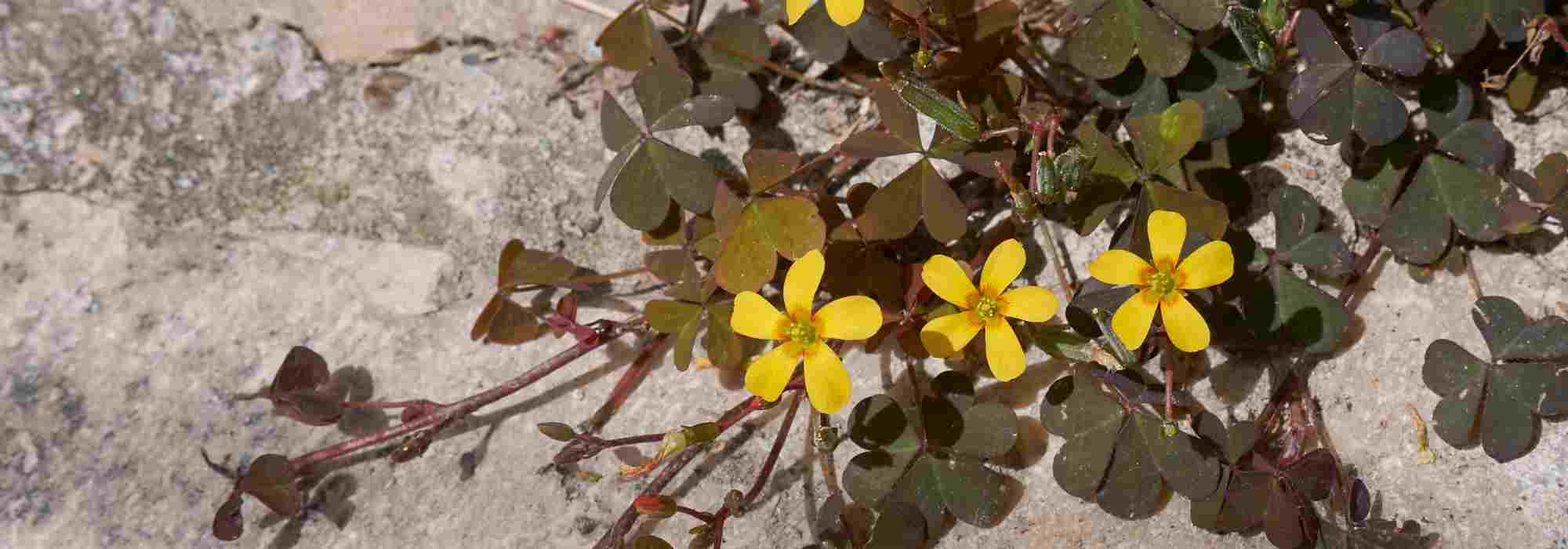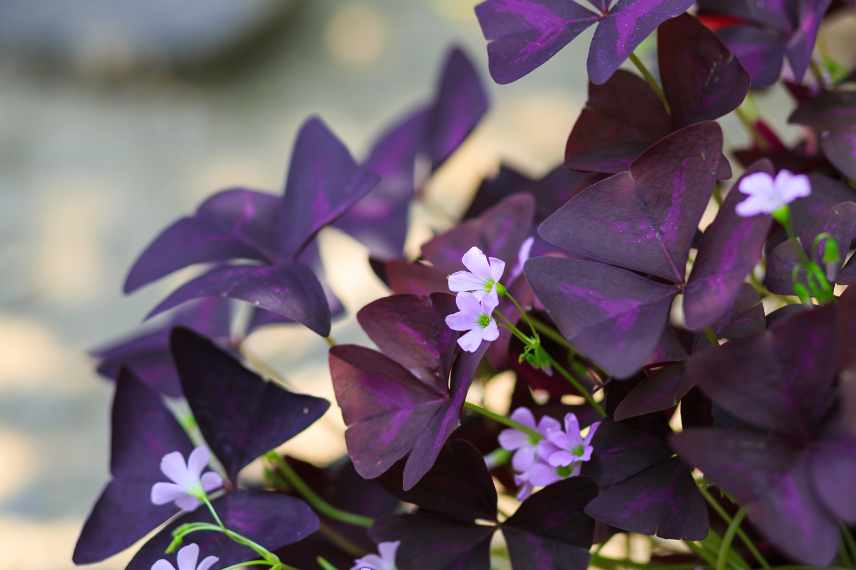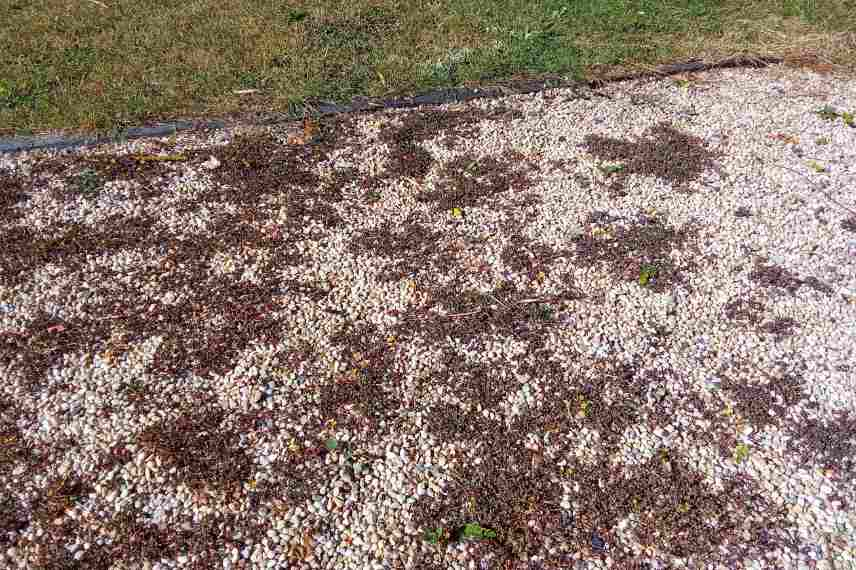
Is Oxalis taking over your flowerbeds or pots? Our solutions to get rid of it.
Prevention, methods and advice against this sometimes overly spreading plant
Contents
The Oxalis are small bulbous perennial plants. They are prized for their decorative clover-like foliage as well as their star-shaped flowering in vibrant colours. Grown indoors or outdoors, they are easy to care for and undemanding.
However, Oxalis sometimes fall into the “weeds” category. It’s true that these bulbous plants can become invasive and quickly colonise space. Let’s explore how to minimise risks and naturally remove overly expansive Oxalis.
Which Oxalis varieties are invasive?
There are different varieties of Oxalis, distinguished by the colour of their foliage or flowers. Around 500 species are known, often originating from South America or South Africa. Eight species are naturally present in France, such as Oxalis acetosella or wood sorrel and Oxalis corniculata or corniculate Oxalis. Growing wild in our territory, they are among the species that can become invasive and are difficult to eliminate. They prefer dappled shade, in woodland areas. They can thus be found spontaneously in fallow land, by roadsides or even at the foot of walls.
Among other species now considered adventive, we can also mention Oxalis stricta (which thrives in short grass meadows on acidic soil), Oxalis articulata and Oxalis pes-caprae (very common around the Mediterranean).
Over time, Oxalis can spread in the garden, smothering other crops.

Top left, Oxalis corniculata; top right, Oxalis acetosella. Bottom left Oxalis pes-caprae and bottom right Oxalis stricta
How do Oxalis multiply?
First of all, Oxalis are easy-to-grow and tolerant plants, which quickly establish themselves in light, humus-bearing soil that remains cool in summer. They thrive in full sun or partial shade. Their main weakness? Limited hardiness, typically between -4 and -9°C. Otherwise, they can flourish in many gardens across our territory.
If Oxalis has a reputation for being somewhat invasive, it’s because these bulbous plants multiply very easily. These creeping plants make excellent ground covers, spreading effortlessly. Though they rarely exceed 30 cm in height, they can form dense, cushion-like mats. Oxalis produce numerous bulblets along their roots, which naturally “give birth” to new shoots. The root system of wood sorrel also tends to develop horizontally. Meanwhile, corniculate Oxalis produces nodes from which small aerial shoots emerge.
Lastly, Oxalis can propel their seeds several centimetres away to propagate. They produce capsules filled with many seeds, which spread uncontrollably.

Oxalis corniculata
Preventing the spread of Oxalis
To prevent the proliferation of Oxalis, there are several solutions.
- If you wish to grow them for their aesthetic qualities, opt for less invasive varieties. Some are even frost-tender, so they will be grown as annuals in our climate, which limits the risk of spreading. This is the case, for example, with Oxalis triangularis, striking and colourful with its beautiful purple foliage. We can also mention Oxalis deppei, with its four-leaf clover-like bicoloured foliage. Let’s not forget Oxalis versicolor, with its astonishing white and red flowering, whose buds resemble real little sweets.
- Especially if you live in a favourable climate (with mild winters), prefer container cultivation to better control the spread of Oxalis.
- Cut the flowers before they fade to prevent seed production. This will limit the multiplication of the plants.
- Avoid leaving the soil bare. Oxalis is a bio-indicator plant, meaning it provides information about the condition of the soil. It tends to thrive on eroded and leached soils, often sandy and silty. As a preventive measure, apply an organic mulch (made of straw, hay, bark, dead leaves, etc.) to the soil or grow other ground cover plants.

Oxalis triangularis
Read also
How to get rid of moss in the lawn?Getting rid of invasive Oxalis naturally
If you want to eliminate overly expansive Oxalis in the garden, there are a few natural solutions. As always, we advise against using chemical products. They are often polluting, harmful to living beings, and not necessarily effective in the long term.
If the Oxalis have developed in a stony area—for example, at the foot of a wall, on a terrace, or between paving stones—you can simply use boiling water. After cooking pasta or potatoes, reuse the still-hot cooking water and pour it directly onto the unwanted plants. Of course, this technique should only be applied to uncultivated areas, as it could completely disrupt soil life and affect nearby plants.
Elsewhere, there’s no miracle solution: manual removal remains the most effective method. Although time-consuming, it ensures long-term elimination of Oxalis. For this, use a weeding knife or a root puller. Make sure to remove the bulbs completely. If any remain in the soil, the plant may regrow. Ideally, carry this out in spring, at the start of the growing season, before the plant regains too much strength and begins flowering. Of course, do not compost these plant waste materials—dispose of them at a recycling centre (remember that burning them is prohibited). Another solution is to regularly cut the foliage back to ground level, to exhaust the plant. However, this method seems much more laborious and will need to be repeated frequently to be effective.
Avoid using a rotavator: as with many “weeds,” it would only contribute to spreading the bulbs—and therefore the plant—throughout the garden. For larger areas, opt for a broadfork or a digging fork, which will help extract the Oxalis root system.
If Oxalis have spread over a large area, you can also deprive them of light to make them wither. To do this, lay an opaque tarp over the area and leave it in place for several months. Weigh it down with large stones or gravel to keep it secure.

Don’t wait until the oxalis are too established! They spread quickly through gravel (photo Gwenaëlle Authier)
- Subscribe!
- Contents































Comments